
Issue 79 • May/June 2023 1 8 2 6 5 8 0 0 5 0 9 2
The Builds of Andreas Lenander Builders Jack England Deepak Shenoy $10.95 INSTRUCTIONS
Mosaics Sculptures
Looks at Brick Art!
AND MORE!

Issue 79 • May 2023 From the Editor................................................... 2 People Andreas Lenander Brick Master....................................................... 3 Thomas Labourot: Comics and Classic Space... ....................... 9 Emerging from a Dark Age: An Interview with Jack England... 13 M’Brick: Brick Mosaic Artist... 17 Jordan Metzgar: Brick Botanist... 21 JacQueline Brick Jeweler... 26 Building brikfont: Exploring Type with Craig Ward.. ......... 30 Zachary Steinman: Sculpting in Bricks and Plates!.. ............ 34 Deepak Shenoy: All About LEGO Mosaics... ....................... 38 BrickNerd Instructions: Arts and Crafts Supplies... ........................ 46 Minifigure Customization 101: Ugh, I smell like a human, Part 2 ........... 56 You Can Build It: MINI Lancer Pursuit Craft ......................... 62 Community Bantha Bricks: Tatooine 66 Last Word 79 Classic AFOLs .................................................... 80 Contents
I “re-discovered” LEGO around nine years ago when my middle son got a set from a friend of mine. After building that set (my son was three at the time, so he was not very helpful...), I realized that this whole LEGO thing was a lot of fun. Shortly after that, my wife bought me a few Star Wars sets, which really got me hooked. I started buying a few sets here and there, and for some reason discovered the concept of MOCs. After that, there was no looking back! I started building my own stuff more and more, and for the past sixto-seven years, I’ve pretty much exclusively built MOCs. As I’ve been building, I’ve noticed that LEGO is a great medium for art. I’ve done some painting (poorly...) before, but the bricks really seem to work well with my brain. I really appreciate the limitations and problem-solving that goes into creating interesting shapes using LEGO. I enjoy lots of different types of art in general, so I guess this is my way of “expressing myself” (I’m trying really hard not to sound too pretentious—ha-ha!).

3
Article and Photography by Andreas Lenander
People
Andreas Lenander: Brick Master
Andreas Lenander (right, with his LEGO Masters partner Emma Friman Browne)
The inspiration for my bricks and color MOCs were a few MOCs that I had seen from around the community. I can’t remember any specific build that inspired me, but I know I was fascinated with the concept of color flowing down like dripping paint. I started experimenting a bit with those types of shapes to see if I could create something that I felt looked good. After a while, I figured it would be kind of fun to add a monochrome minifigure that sort of ‘came alive’ from the flowing color. For some reason, I started thinking about the whole chicken-or-egg discussion [what came first, the chicken or the egg?- Ed.] which led to the addition of the oversized brick to this equation. The concept felt like something I would enjoy seeing myself, so I decided to build it. The response to the first build was pretty overwhelming, so that inspired me to add more versions with different colors. Eventually, that led to the rainbow picture where I added the base colors, and also a few combinations to get that rainbow look.

That’s pretty much the story of how those builds came together. There were a few challenges in designing the brick and the flow of color, especially because I wanted to pose the brick at an angle, but at the same time have at least some sense of stability. The inner structure of the builds has gone through a few iterations, but I’m pretty happy with them at this point.

 Andreas’ creation Dádýr.
A fire dragon.
A happy dragon.
Andreas’ creation Dádýr.
A fire dragon.
A happy dragon.
Comics are a great source of inspiration for builders. And while this is exactly how I started a previous article for BrickNerd on The Unicorn from Tintin, it holds so very true for this feature on Thomas Labourot, aka Legolabo, a French comic book artist and classic space builder I had the chance to chat with.
Being a big fan of comics, I just had to know how Thomas merges these two passions—I hope you’ll enjoy our conversation as much as I did!

Sam: Hello Thomas, I’m honoured to be talking to you. To start off, would you mind introducing yourself?
Thomas Labourot : Hi Sam, I am a 45-year-old boy who likes to draw and play, to tell stories, and to create worlds to escape to.

You are a comic book writer by profession. What are some of the titles you worked on, and were any of them published in the US?
I’m currently working on a new series whose first volume has just been released in July: A-LAN at Dupuis with BEKA helming the script. This year I also released Animal Farm, an adaptation of George Orwell’s novel at Jungle with Maxe l’Hermenier writing the script, and at the beginning of October, I released an adaptation of Charles Dickens’ Christmas Carol! I also finished my series Aliénor Mandragore at rue de sèvres, with Séverine Gauthier taking care of the script.
An American first volume of Aliénor is available; the others are too recent.

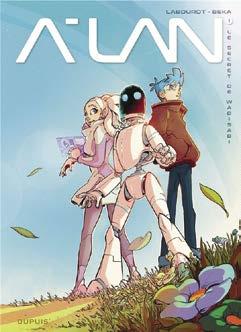
You work out of Workshop 510 together with other renowned comic authors. Can you tell us a bit about that special work environment?
It’s a workshop of more than 130 square meters where dust fights without mercy in the middle of a lot of toys, books, and pots of paint! And in the middle of all that, there are seven people who live there from morning to evening, who work there and create comic strips. There is a scriptwriter, some French-Belgian cartoonists, comic book artists, and colorists, and all of them try to cohabit in this geek’s den!
9 People
BrickNerd.com Thomas Labourot: Comics
Article by Samuel Pister of
and Classic Space
A sampling of the graphic novels done by Labourot.
The use of pieces from the Classic Space era remains a constant, but you use a lot of recent pieces in your MOCs, too. How do you decide which pieces to use?

Yes, I use only the new gray, light and dark, and regular blue! Trans-yellow for everything transparent, and I allow myself to use trans-orange for the engines! I’m a rebel...

For me, Classic Space is these colors. On the other hand, there is no limit on the parts as long as they are of the right color. Nor on the color of the minifigures—I use a little bit of everything...

You are (among others) a very big fan of Akira Toriyama. Can you explain to us to what extent you find inspiration in his universe, to adapt it to your creations?
Akira Toriyama, father of Slump and Dragon Ball among others, loves making models, and he is passionate about everything that is a military vehicle. He merges his two passions in his drawings and I love it—he deforms them, using very geometrical shapes in his interpretation of vehicles in his illustrations. In short, he inspires me! He is my spiritual master, and for some creations I was directly inspired by some of his drawings.

 Some of Labourot’s models.
A build inspired by an illustration by Akira Toriyama, seen at the right.
Some of Labourot’s models.
A build inspired by an illustration by Akira Toriyama, seen at the right.
If you attended Bricks by the Bay, a California LEGO fan convention, you may have noticed the gorgeous MOC of a portrait of a dog used as the program book’s cover image. The MOC is actually a memorial to builder Jack England’s beloved pet, Arden. Jack works professionally training seeing eye dogs, and while Arden wasn’t a fit as a service dog, he found service as man’s best friend. Arden lives on in this exquisite piece of art.

Jack’s other MOCs—which involve a variety of styles, nice parts usage, and fresh techniques—all caught my eye. It was hard to believe that Bricks by the Bay was Jack’s debut in the AFOL community; I welcomed him with Nerdy gushing, and he honored me with an interview.
Gwyneth Kozbial: Please start off by telling us a little about yourself. Where are you from, and how long have you been involved with LEGO building?
Jack England: I am from Salt Lake City, Utah originally, and now live in Emeryville, California. I am 30 years old. I built LEGO as a child through Junior High, then stopped like many others. l got my first set as an adult during COVID and have been building ever since (2+ years). As a kid, I mostly built sets, then I made up my own things—but nothing as a serious project. As an adult, my interest has been primarily in MOCs; I mostly have interest in sets only for the parts.
You must have built quite a foundation as a child to come up with these creations in only two years. How did you come out of your Dark Age?
What primarily sparked my interest in LEGO as an adult was watching the first season of LEGO Masters, combined with looking for things to do during the pandemic. Before seeing the show, I had never really thought about LEGO as an adult, since (unfortunately) selling a lot of my collection before I started college. I was amazed at the variety of new parts and colors and what the contestants were able to sculpt. From there, I jumped into the online community to see all the amazing MOCs out there for inspiration.
Article by Gwyneth Kozbial of BrickNerd.com Photography provided by
England
13
from
People
Jack
Emerging
a Dark Age: An Interview with Jack England
Jack England with some of his work.
Jack’s first effort at building an organic shape: his pug’s face.

Many builders took up LEGO during the pandemic to cope with the isolation. Are you part of a LUG or online building community? This is the first I’ve seen of you at a convention, and your online presence is even newer than that. After seeing Flynn and Richard on LEGO Masters and learning they lived in the Bay Area, I participated in some of the TrickyLUG challenges which have sparked the inspiration for many of my builds. I also met a lot of awesome people from BayLUG at Bricks by the Bay (BBTB), so I am interested in joining them as well. BBTB was my first convention. I’ve shared some things on Reddit before, and I just recently started an Instagram account for my builds (@ ardent_bricks). My partner is very supportive of my hobby and even lets me display my MOCs in the living room!
TrickyLUG is a really supportive community; I love their challenges. Do you have other hobbies that play into your LEGO building?
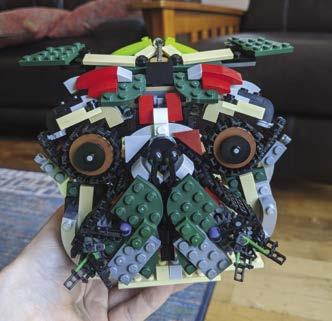
This is one of my primary hobbies right now, at least as my outlet for art. Others include rock climbing and juggling.
How did you begin MOC building? What was your first AFOL creation? We’d love to learn more about your process.

It’s hard to say what my first real MOC was, as I had to make the most of limited pieces initially. I enjoyed the challenge of puzzling together pieces to sculpt an organic shape, and figuring out unique ways to connect them. I tried making a bust of my pug’s face. I thought it was pretty successful, despite the wrong colors and lack of pieces to finish it. Not too tough a process.
My first large-scale MOC was for a two-week free build challenge. It started with a jellyfish made of mostly translucent orange parts. I decided to make the base the mouth of an anglerfish, with the jellyfish attached as a deceptive bait with a light glowing. I made a scuba diver unsuspectingly swimming toward the enticing light to complete the scene (dark, I know).
Sanguine and Plaza.
M’Brick: Brick Mosaic Artist!
Article by Joe Meno Photography by M’Brick
M’Brick is a French brick artist that has made a name for himself on Instagram making mosaics. His feed is filled with his creations—large pixellated paintings and street art, all done with LEGO. He first built with LEGO as a boy, but went into a Dark Age when he became a teenager.


He started his artistic journey 15 years ago when he wanted to make a painting. After trying several different approaches to painting, he ended up using LEGO to make mosaics.
After that first return to the brick, it was another several years before he had a desire to for street art expression, again wondering what he would use as a medium. He looked back at the painting and asked himself, “Why not do street art with LEGO?”
That question inspired him to build his LEGO art, and his continuing inspiration is his desire to create art. Other inspirations include, as he states, “The universe around me and the things that I like.” He also loves sneakers, cars, watches, street art, and hip hop.

17
People
M’Brick’s portrait of Frida Kahlo.
A close-up of the portrait.
Do the LEGO Botanical series sets pass muster with a botanist?
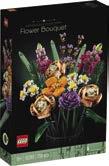
The last few years have been an exciting time to be both a botanist and an AFOL. The LEGO group has introduced fun, flowery builds like the cheery Floral Art set (31207), begun using plant-based plastics to produce parts, and launched the stunning Botanical Collection.
As a botanist, I study plants. In my case, I focus on the diversity of plants, especially the world’s ferns and the southeastern USA’s plants and their ecology, or how they fit into their local environment. I am the curator of the Virginia Tech Massey Herbarium, which is a botanical museum that supports education and research.
I love to combine my passions for botany and LEGO. I have sponsored botanical LEGO contests for local kids, used brick building activities to teach evolution in my college courses, and made MOCs of my students’ research projects as their graduation presents. Needless to say, I was an immediate fan of the Botanical Collection!
These sets feature some fabulous part usage and are gorgeous display models. But do these new plant builds pass scientific muster? Let’s take a look at these five Icons-level sets and see how they compare with their real-life inspirations.

Flower Bouquet 10280

The bouquet is a versatile set that would be a great Valentine’s gift for the AFOL in your life. This set begs you to try some creative display possibilities, since no vase is included. Six different types of flowers are included, along with a couple greenery options. Out of the aster (Asteraceae), California poppy (Eschscholzia californica), common daisy (Bellis perennis), lavender (Lavandula), rose (Rosa), and snapdragons (Antirrhinum), I found the aster and snapdragon to be the most interesting.
Building
Jordan Metzgar: Brick Botanist
21
The purple aster flower cluster from the Flower Bouquet set (left) and live chrysanthemum flower cluster (right). A single floret for both the build and a live chrysanthemum are shown in the middle, with a magnified look at the female pistil inside the floret.
Article by Joe Meno
Photos by Cole Rodger
JacQueline Brick Jeweler
LEGO building is the art of creating. Using a seemingly unlimited palette of parts, one can build almost anything. Discovering the limitations of the bricks and elements is part of the art, and poses a question: Do you stay with the limitations of the brick, or do you go farther?
Jeweler JacQueline encountered this challenge from another angle... she wanted to make jewelry with plastic. She was very interested in using color in her work, but wasn’t interested in colored stones. Working with plastic, though, is too toxic for a small studio. In 2002, she had a “Eureka moment” when she thought of LEGO bricks.
JacQ made her first piece of LEGO jewelry with a minimalist look in mind. Sanding off the logo and sandblasting changed the brick from a shiny toy to create a more sophisticated aesthetic.


In the years following, JacQ got recognized at galleries and eventually by the LEGO Group itself as a member of LEGO’s Creation Nation. JacQ got an appreciation for the quality of the brick when she tried to use another company’s bricks and discovered that their bricks would melt during sanding and had mold lines and other inconsistencies. After that, she fell in love with LEGO bricks and later, the company and fan community.
JacQ creates her work using LEGO elements, precious metals and diamonds, by cutting, sanding, drilling, and sandblasting LEGO elements to alter their appearance. Sandblasting achieves a matte finish to create simplicity to a shiny beautiful brick. She also cuts from the elements, eventually recycling and reusing parts in her pieces. Craftsmanship is very important to her, so she is always trying to hand fabricate all her clasps and create connections that are unique and surprising to the viewer. As a result, her work has evolved from telling her forever young story with more of a sophisticated perspective, while still honoring “play” in her Portland Skies collection.
People
26
JacQ took some time with me to talk about some of her pieces:
This was the first Rainbow pendant I created. Each plate is filed down and sandblasted.
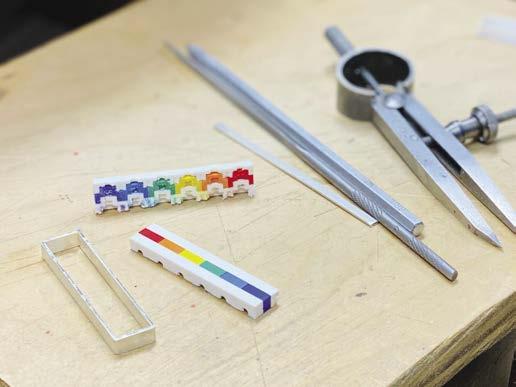
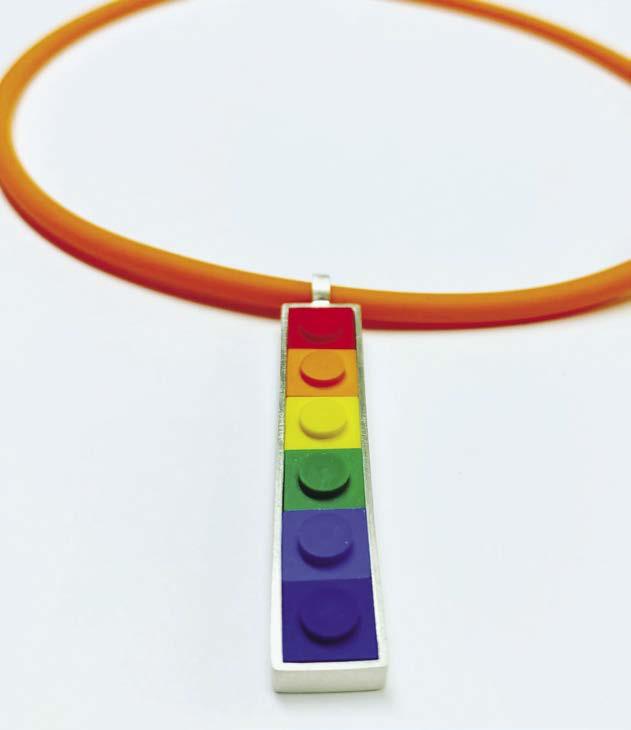
When I put the LEGO bricks together for this pendant, I cut the piece in half with a saw so it is not too thick. I then hand-fabricate the silver bezel around it. I was inspired by a MOC by builder Bruce Heller to create this piece. To the average person, this does not come across as LEGO bricks, so I love the simplicity and mystery of that.

I like to utilize all the pieces of the LEGO brick. I fabricated this bracelet by drilling holes in the studs of a brick, sawing off the tops and then sanding them even to cre ate the links. I like asking AFOLs if they recognize where the pieces come from. I like how surprised they are when I tell them.
 Linear Rainbow Pendant
Rainbow Pendant
Rainbow Cascade Bracelet
Linear Rainbow Pendant
Rainbow Pendant
Rainbow Cascade Bracelet
27
brikfont: Exploring Type with Craig Ward
Typography is the study and creation of letter and number forms into common families—known as typefaces or fonts. Typographers made the typefaces and fonts that are used everywhere, from signs to computer displays. Exploring letterforms usually is done with drawings and renderings... until Craig Ward began using LEGO elements.
Craig is a graphic designer with an impressive portfolio. Since graduating college in 2003, he has been in the advertising field, with a couple of Design Director roles at a couple of agencies under his belt. He also started his own portfolio of typographic work in parallel and became a freelancer in 2012. Since then, he has picked up an eclectic array of clients, including Calvin Klein, Dior, Adobe, Zoom Kings of Leon, Domino Records, and others. His work has also been seen on the covers of Wired, Time, and the Washington Post.
In mid 2021, he was (like the rest of us) in the middle of a pandemic lockdown. Stuck at home, he was working with the Wall Street Journal on a proposal for a brand identity system that used visible grids and was referencing the Wim Crouwel/Vormgevers poster from 1968, which he always loved.


30
Article by Joe Meno
Photos and Art by Craig Ward
Building From a 1968 poster...
...to a LEGO mosaic.
Building
Zachary Steinman: Sculpting in Bricks and Plates!

 Article by Joe Meno
Article by Joe Meno
A LEGO builder on Instagram has made a name for himself making sculptures based on LEGO. Building a cube with studs on all faces, Zachary Steinman has been creating an expanding collection of sculptures with differing surface treatments. Patterns and grids are seemingly carved into the surface of these cubes, making them appear as if made from something other than studded bricks and plates.
 Photos by Zachary Steinman
Some of Zachary’s builds. The build above was inspired by artist Nikolaus Weller.
Photos by Zachary Steinman
Some of Zachary’s builds. The build above was inspired by artist Nikolaus Weller.
Deepak Shenoy:
All About LEGO Mosaics
Article and Photography
by Deepak Shenoy
Introduction
A mosaic in the traditional sense is a picture or pattern created by arranging together small colored pieces of stone, glass, etc. As the name implies, a LEGO mosaic is a mosaic created using LEGO pieces. Unlike traditional mosaics where the pieces of stone or glass need to be cut to size and mounted on some kind of a substrate using glue, we can create a LEGO mosaic simply by attaching LEGO bricks, plates and other elements to one or more baseplates.
So, how exactly do you go about designing a LEGO mosaic? Some LEGO artists have the amazing ability to use trial and error to create mosaics freehand, but the rest of us have to rely on some kind of software to aid us in this effort. We need this software to be able to take any image that we provide it and turn it into the best approximation that is possible of the image, using the available LEGO pieces and colors.
To understand how LEGO mosaic software works, let us first take a closer look at the typical starting point for a LEGO mosaic—namely a digital image. Digital images may be ubiquitous on our smartphones and computers, but it is helpful to understand how the data in an image file is organized. An image is basically a two-dimensional grid of square picture elements (or pixels) each of which has a particular color. All the pixels (especially when there are enough of them) blend together in our brains to create the illusion of a continuous image with light, shadows, shapes, colors, and textures that resemble what we see in the real world.

38
Building
“San Giorgio Maggiore at Dusk” by Claude Monet.
The pixel grid in an image is analogous to the regular square grid of stud locations in the LEGO system. And so, if we can somehow map each pixel in the image to a LEGO 1×1 brick or plate, we can create a LEGO representation of the digital image, or in other words, a LEGO mosaic. However, it is not always as simple as that. In fact, a LEGO mosaic can at best only be a very crude approximation of the original image, and there are two reasons for this: The resolution of the image and its color depth.
Resolution
The resolution is the level of detail that is captured in the image and it is proportional to the number of pixels that it has (the more pixels that an image has, the more details it is able to capture). You normally cannot see the individual pixels that make up a digital image (unless you zoom into it all the way using a photo editor like Photoshop) and that is because of the sheer number of pixels that make up a typical image.

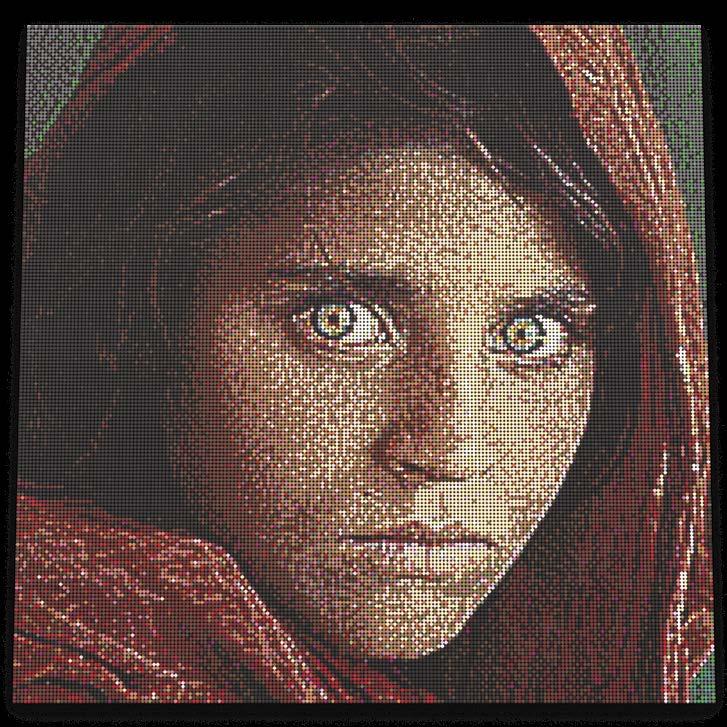
The earliest digital cameras from the late 1990s produced images with what would now be considered a very low resolution—typically something like 1024×768 pixels, which is under one megapixel (a commonly used unit that is equivalent to one million pixels). But if we translate that to LEGO where the smallest element we can use to represent each pixel is a 1×1 brick or plate (with a footprint of 0.8×0.8 cm), we would end up with a LEGO mosaic that is 27×20 feet wide !
So clearly, we have to reduce the resolution (number of pixels) of the source image dramatically before we can represent it using LEGO. For instance, if we downsize the 1024×768 image by a factor of 8, we would end up with 128×96 pixels. This would work out to a large (but more manageable) mosaic that is 40×30 inches wide. This process comes with a significant loss of fine detail in the resulting LEGO mosaic. It is also more challenging to create the illusion of a continuous image because it is hard not to see the individual pixels that make up a LEGO mosaic. It’s no wonder that most LEGO mosaics don’t look like much when viewed up close. You always have to step back a few feet to get the intended effect of the mosaic.
Color Depth
Next, we look at color depth. In a typical color image, each pixel has eight bits of data for each of the three primary colors: Red, Green and Blue. By combining these three primary colors in the correct proportion, we can represent more colors in the color spectrum than humans can actually perceive. Each bit can have two values (0 or 1) and so eight bits allow us to represent a total of 2x2x2x2x2x2x2x2 = 256 total values (0 to 255) for the intensity of each primary color, and together we have a total of 256x256x256 = 16.7 million possible combinations, each of which is a distinct color in the color spectrum. When we create a LEGO mosaic, we have to map those 16.7 million colors to the forty or so commonly available colors in the LEGO color palette.
39
A close-up showing the pixels (tiles) in the mosaic.
A mosaic of the famous “Afghan Girl” photograph from National Geographic
Arts and Crafts Supplies
Design and Instructions by the BrickNerd Team

It’s time to get crafty! For the art theme in this issue, we designed three mini-builds of art supplies you’d find at a craft shop, including scissors, a paintbrush and some paint, and an easel and canvas.
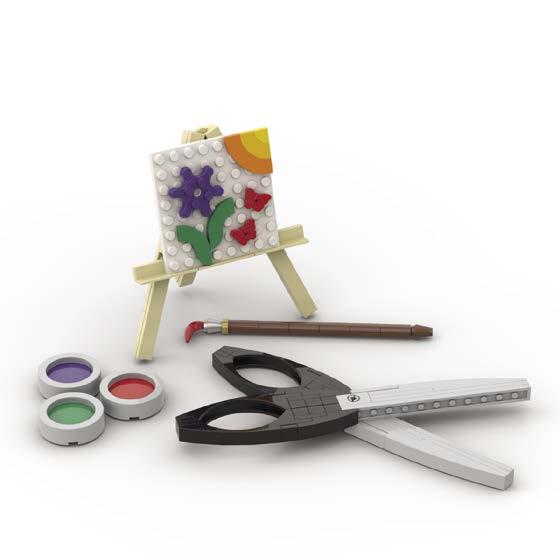
The scissors feature back-to-back mudguards for the shape of the handles using a fun SNOT technique made possible with the new 1x1x2/3 brick with a hole in it. They also pivot like a real pair, though we don’t recommend using them to cut any paper.
For the paint supplies, you can customize your paint colors and canvas with whatever you want, using new 3x3 circle tiles. Also see if you can find the well-placed banana used in the paintbrush.
Lastly, the easel and canvas can be used for many different things. Need a MOC card holder at a LEGO convention? Use the mini easel! Want to create your own 8x8 masterpiece? Go for it! Oh, and those older red butterflies can be substituted with the newer yellow ones too (80674).
This was a fun collection to design. We hope you enjoy building them just as much as you like to get artistic with the brick!
Parts List
(Parts can be ordered through Bricklink.com by searching by part number and color)
Qty Part Color Description
1 35442.dat Md. Lilac Plate Gear 6 Tooth 2 x 2
1 67095.dat Md. Lilac Tile 3 x 3 Round
4 3023.dat Black Plate 1 x 2
4 3024.dat Black Plate 1 x 1
4 3070b.dat Black Tile 1 x 1 with Groove
1 30364.dat Black Hinge Brick 1 x 2 Locking with Single Finger On End
6 32062.dat Black Technic Axle 2 Notched
1 44302a.dat Black Hinge Plate 1 x 2 Locking with Dual Finger on End Vertical with Groove on Short Side
4 50967.dat Black Slope Brick Curved 8 x 1 x 1 & 2/3 with Arch
4 61678.dat Black Slope Brick Curved 4 x 1
12 86996.dat Black Plate 1 x 1 x 0.667
2 25269.dat Green Tile 1 x 1 Corner Round
2 27925.dat Green Tile 2 x 2 Corner Round
1 67095.dat Green Tile 3 x 3 Round
1 25269.dat Yellow Tile 1 x 1 Corner Round
3 2429.dat Tan Hinge Plate 1 x 4 Base
3 2430.dat Tan Hinge Plate 1 x 4 Top
2 3623.dat Tan Plate 1 x 3
3 3666.dat Tan Plate 1 x 6
3 4162.dat Tan Tile 1 x 8
2 6636.dat Tan Tile 1 x 6
3 15207.dat Tan Panel 1 x 4 x 1 with Rounded Corners, Thin Wall
2 60479.dat Tan Plate 1 x 12
1 69729.dat Tan Tile 2 x 6
1 27925.dat Bright Lt Orange Tile 2 x 2 Corner Round
1 20482.dat Pearl Gold Tile 1 x 1 Round with Pin and Pin Hole
1 79393.dat Orange Tile Round Corner 3 x 3 Macaroni
1 4589.dat Reddish Brown Cone 1 x 1
6 59443.dat Reddish Brown Technic Axle Joiner Inline Smooth
1 33085.dat Red Minifig Food Banana
1 67095.dat Red Tile 3 x 3 Round
2 95828.dat Red Animal Butterfly with Stud Tube and Pin Hole
1 15573.dat White Plate 1 x 2 with Groove with 1 Centre Stud, without Understud
1 41539.dat White Plate 8 x 8
1 3673.dat Lt. Bluish Grey Technic Pin
2 3700.dat Lt. Bluish Grey Technic Brick 1 x 2 with Hole
2 3710.dat Lt. Bluish Grey Plate 1 x 4
2 4477.dat Lt. Bluish Grey Plate 1 x 10
2 60479.dat Lt. Bluish Grey Plate 1 x 12
2 63864.dat Lt. Bluish Grey Tile 1 x 3
3 68325.dat Lt. Bluish Grey Brick 4 x 4 Round with 3 x 3 Recess with Hole and Snapstud
2 85970.dat Lt. Bluish Grey Slope Brick Curved 1 x 8 with Plate 1 x 2
1 59900.dat Metallic Silver Cone 1 x 1 with Stop
6 78258.dat Dark Bluish Grey Bar 2L with Thick Stop and Pin Holes
46
Minifig Customization 101:

Ugh, I smell like a human, Part 2
Article and Photography
by Jared Burks
Continuing our dive into the world of San and Ashitaka from Princess Mononoke, we will complete the figures today. If time and space hold out, I may even tackle a small vignette to display the characters. For those that missed the last issue, Princess Mononoke is an animated film set during the 14th Century, the Muromachi period of Japan. Princess Mononoke tells the story of Ashitaka, a young prince cursed by the hatred of a dying boar god. The boar was corrupted by being shot with an iron ball, which lodged in his body. “Hear me loathsome humans,” the boar says. “You shall know my agony and my hatred”. Ashitaka seeks a cure for this curse transferred to him by the boar god by traveling across the land, hoping to find the Shishigami, a deer-like forest spirit with the power to bring life and death. During his travels, Ashitaka discovers a world out of balance. The ironworks community of Tatara, run by the enigmatic Lady Eboshi, is ravaging the nearby forest for resources, provoking the wrath of ferocious wolf god Moro and her feral human daughter San (the titular Mononoke, which roughly translates to specter or wraith). Ashitaka is caught in the middle and he must figure out how to navigate this difficult world with “eyes unclouded.”
Here is an updated listing of builds for the characters of Princess Mononoke, showing what was made last issue and what is in this issue.

56 Building
Yakul (Ashitaka’s Mount)
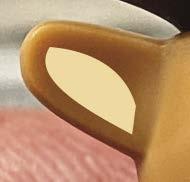
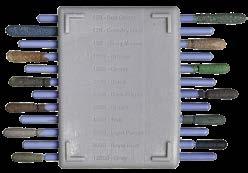
Since we are working on the animal characters, let’s take a look at Yakul. Most of his work was performed in the last issue with the horns and saddle. That said, I really wanted to make him appear furrier, and to do this I wanted to add vinyl stickers. I could hand paint these details, but outlining the fur to make it two-tone would have been a major challenge. I could use the vinyl stickers as a masking and paint Yakul, but for now they will just stick on. To start this process, I needed to create a template to draw the design. By taking a set of photos and figuring out the scale of the photos, you can draw the needed pieces directly on top of the photos and use them as your underlying template. The below neck fur was a touch more complicated, as that fur wraps around multiple sizes, and there are contour lines that I wished to follow, so I created a much more complex template that I followed when creating that design.
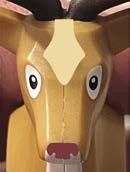



Kodama - Tree Spirits (Bonus Items)
The Kodama are these little tree spirits that lead Ashitaka to safety in the film, and reappear multiple times throughout when interesting things take place. Oddly enough, their heads bobble side to side, and in the long term I may construct a LEGO bobble head for them. But for today, I have customized a LEGO baby by painting it white with vinyl dye, and then created a custom 3-D printed baby head to go with the painted LEGO baby. The custom LEGO styled baby head was modified in how it attaches to the baby body. The internal post was modified so that the head goes on at a 7.5-degree angle instead of straight-on. This allows the head to tilt or cant to one side or the other to replicate the bobble. Based on how I turn the head, it will cant left, right, forward, or backward, so only one modification is needed, and many effects are possible. To create the Kodama’s faces, I simply painted them by hand, as their eyes are not very uniform in size or scale, and I thought a hand-done fast paint job would replicate that effect.

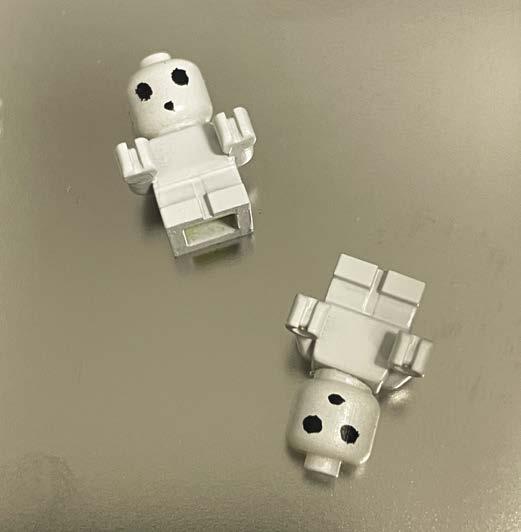 The area below the eye is cleaned with sanding swabs (left).
The templates used create the vinyl stickers for Yakul.
Stickers in place.
The finished Kodama in place.
The area below the eye is cleaned with sanding swabs (left).
The templates used create the vinyl stickers for Yakul.
Stickers in place.
The finished Kodama in place.
58
Kodama close-up.
You Can Build It
Lancer Pursuit Craft
Design and Instructions
by Christopher Deck
Hello everybody, and welcome to the latest MINI model building session! These are exciting days in the Star Wars universe, looking at the recent launch of the newest live-action television series Andor. As images and background information are still rare these days, we will build a nice little spacecraft that appears in the series Andor, but was already shortly featured in the animated television series Rebels. We are talking about the Lancer-class Pursuit Craft.
It is a difficult ship to build due to its special shape. It features elements of a dome, and dish with a trapezoid rear part. Attached to both sides are large engine cylinders. The ship is also heavily armed. It took a long time, until finally a solution turned out to work properly for this shape. We make use of an unusual part which does the perfect job to combine several of the shape elements. The modified 6x6 cross plate with dome (part number 30303) is a relatively large piece you would not expect in a fragile looking mini model, but it smoothly disappears in the construction.
Another highlight is the use of the minifigure lantern with handle in combination with the hinge piece with claw end (part number 41529). The claw nicely covers the large handle of the lantern which represents the engines in a decent way. I hope you will enjoy building this little model! Have fun, and see you next time!
Parts List (Parts can be ordered from Bricklink.com by searching by part number and color)
2 Lt-Bluish-Gray 99780.dat Bracket 1 x 2 - 1 x 2 Up
2 Trans-Lt-Blue 3062b.dat Brick 1 x 1 Round with Hollow Stud
2 Lt-Bluish-Gray 58176.dat Cylinder Domed 1 x 1 x 1.667 with Bar
2 Lt-Bluish-Gray 30552.dat Hinge Arm Locking with Single Finger and Axlehole
2 (Old) Dark-Gray 41529.dat Hinge Wedge 1 x 3 Locking with 2 Fingers, 2 Studs and Clip
3 (Old) Dark-Gray 30162.dat Minifig Binoculars with Round Eyepiece

2 Black 85975.dat Minifig Hat Fez
2 Lt-Bluish-Gray 37776.dat Minifig Lantern
1 Black 3024.dat Plate 1 x 1
1 Lt-Bluish-Gray 6019.dat Plate 1 x 1 with Clip Horizontal (Open U-Clip)
1 (Old) Dark-Gray 3023.dat Plate 1 x 2
1 Lt-Bluish-Gray 32028.dat Plate 1 x 2 with Door Rail
1 Lt-Bluish-Gray 2540.dat Plate 1 x 2 with Handle
1 Lt-Bluish-Gray 3839b.dat Plate 1 x 2 with Handles Type 2
2 Lt-Bluish-Gray 3022.dat Plate 2 x 2
2 Lt-Bluish-Gray 2420.dat Plate 2 x 2 Corner
1 Lt-Bluish-Gray 18674.dat Plate 2 x 2 Round with 1 Centre Stud
2 Lt-Bluish-Gray 26601.dat Plate 2 x 2 without Corner
1 Lt-Bluish-Gray 3021.dat Plate 2 x 3
1 Lt-Bluish-Gray 3020.dat Plate 2 x 4
1 Yellow 18646.dat Plate 3 x 6 Round Half with 1 x 2 Cutout
1 (Old) Dark-Gray 30303.dat Plate 6 x 6 x 0.667 Cross with Dome
1 Lt-Bluish-Gray 85984.dat Slope Brick 31 1 x 2 x 0.667
1 Black 28192.dat Slope Brick 45 2 x 1 with Cutout and without Stud
2 Lt-Bluish-Gray 32449.dat Technic Beam 4 x 0.5 Liftarm
2 Lt-Bluish-Gray 4274.dat Technic Pin 1/2
2 Lt-Bluish-Gray 2412b.dat Tile 1 x 2 Grille with Groove
1 Yellow 41770.dat Wing 2 x 4 Left
1 Yellow 41769.dat Wing 2 x 4 Right
1 Lt-Bluish-Gray 48183.dat Wing 3 x 4 with 1 x 2 Cutout with Stud Notches
62
MINI Build MINI
Qty Color Part Description
fleet
Tatooine
Article by Steven Smyth, Bantha Bricks: Fans of LEGO Star Wars

Photography by Cyril Linard
Galactic greetings! I’m Steven Smyth from Bantha Bricks: Fans of LEGO Star Wars.
Since the community’s founding in 2016, on an almost daily basis, I have witnessed amazing and creative Star Wars builds in the best Star Wars themed building brick group on Facebook. Xavier Laffray and Frank Averstegge are such creative builders, and recently shared a custom collaboration build of Tatooine with a large group of AFOLs.

Steven Smyth: How’s it going, guys? I’ve known you two for years now through the Facebook group; first as members, and then as moderators of the all-volunteer Admin Team that helps monitor the group content to maintain a family-friendly atmosphere. Everyone in Bantha Bricks has been wowed by your many awesome Star Wars brick builds, but here recently you have really upped your game with this massive Tatooine diorama! Where did this take place?
Frank Averstegge: The Olivet Bricks 5éme Edition event took place in Olivet, France, which is a town near Orléans and about 100km from Paris.
Who were all the builders that participated?
Xavier Laffray: The team behind this massive undertaking was Mélodie Baron, Fabien Bois, Sébastien Le Querrec, Cyril Linard, Stéphane Mainil, John Quairia, Carmen Deville, Jean-Jacques Taillé, Victor Boscá Cárcel, Frank Averstegge, Xenia Mai and myself, Xavier Laffray.
That is an impressive line-up! I recognize many of those names, especially Victor. With that many builders bringing their creations together, I have to ask: About how many LEGO bricks do you estimate were used?
Frank: Puhhhhh! That is a good question; I think we estimated that it must be a million or even more. So many
66
starship
IF YOU ENJOYED THIS PREVIEW, CLICK THE LINK TO ORDER THIS ISSUE IN PRINT OR DIGITAL FORMAT!
BRICKJOURNAL #79


Create Brick Art with builders ANDREAS LELANDER and JACK ENGLAND! Learn how to build mosaics and sculptures with DEEP SHEN and some of the best LEGO builders around the world! Plus: AFOLs by cartoonist GREG HYLAND, step-by step “You Can Build It” instructions by CHRISTOPHER DECK, BrickNerd’s DIY Fan Art, Minifigure Customization with JARED K. BURKS, and more!
(84-page FULL-COLOR magazine) $10.95 (Digital Edition) $4.99 https://twomorrows.com/index.php?main_page=product_info&cPath=98_78&products_id=1695





 Andreas’ creation Dádýr.
A fire dragon.
A happy dragon.
Andreas’ creation Dádýr.
A fire dragon.
A happy dragon.








 Some of Labourot’s models.
A build inspired by an illustration by Akira Toriyama, seen at the right.
Some of Labourot’s models.
A build inspired by an illustration by Akira Toriyama, seen at the right.
















 Linear Rainbow Pendant
Rainbow Pendant
Rainbow Cascade Bracelet
Linear Rainbow Pendant
Rainbow Pendant
Rainbow Cascade Bracelet



 Article by Joe Meno
Article by Joe Meno
 Photos by Zachary Steinman
Some of Zachary’s builds. The build above was inspired by artist Nikolaus Weller.
Photos by Zachary Steinman
Some of Zachary’s builds. The build above was inspired by artist Nikolaus Weller.














 The area below the eye is cleaned with sanding swabs (left).
The templates used create the vinyl stickers for Yakul.
Stickers in place.
The finished Kodama in place.
The area below the eye is cleaned with sanding swabs (left).
The templates used create the vinyl stickers for Yakul.
Stickers in place.
The finished Kodama in place.




